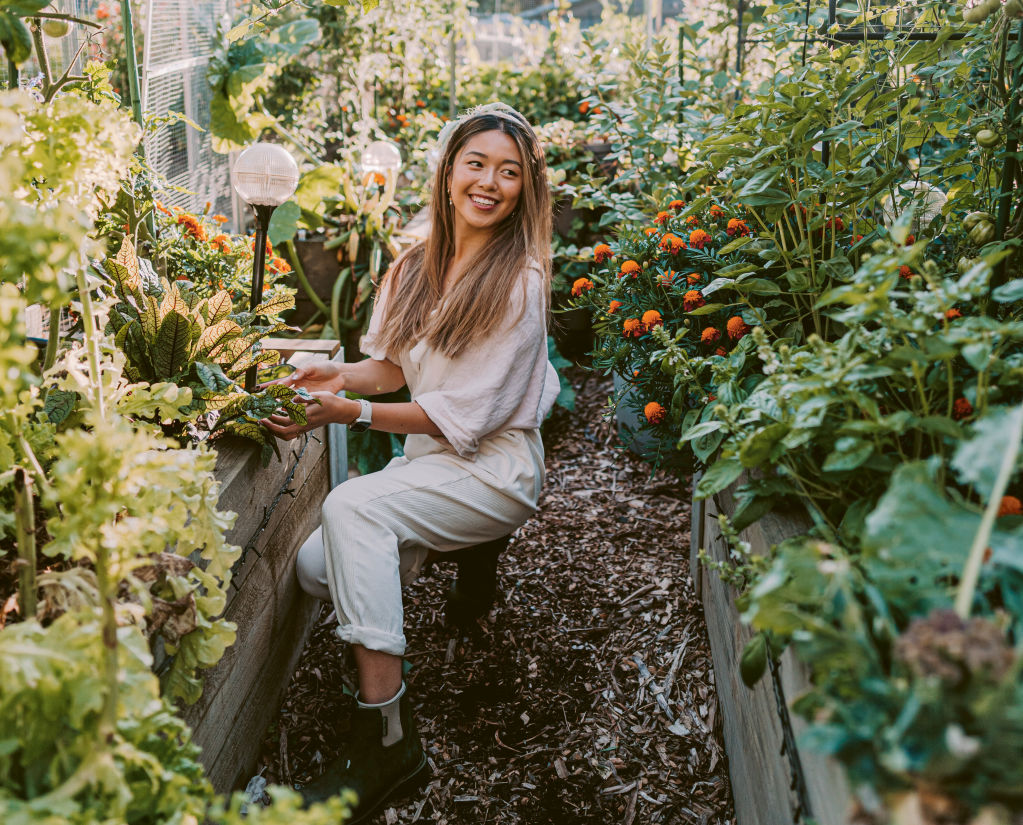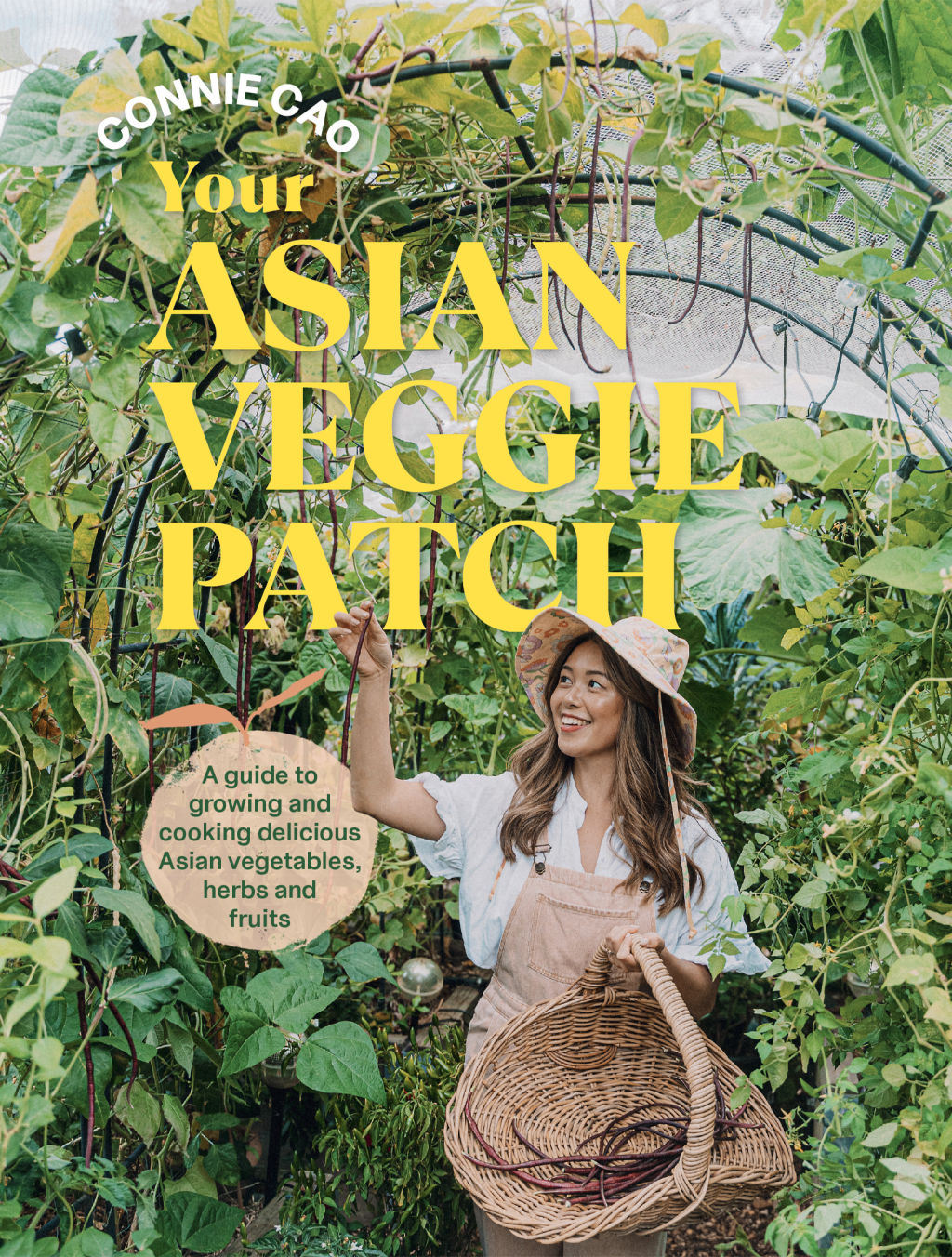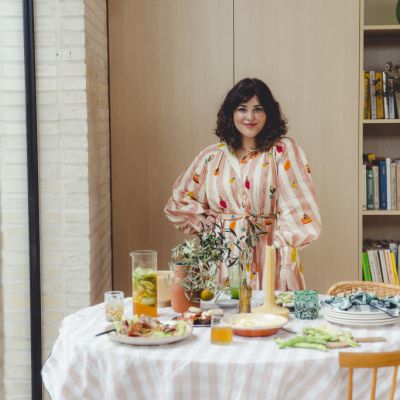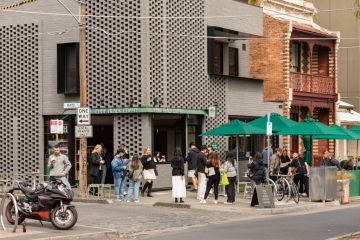How to grow (and eat) Asian veggies with gardening guru Connie Cao

Some people dream of a suburban backyard with a sprawling green lawn and Hills Hoist. Connie Cao fantasised about planting an urban food forest. Since 2018, Cao and her partner Tom have turned this dream into reality from their backyard in Melbourne’s outer east. Densely packed with fruit trees, flowers and an enviable veggie patch, every inch of Cao’s home garden teems with life.
Cao is not your typical gardening guru. The young (by gardening-world standards) digital creator and now author of Your Asian Veggie Patch, has shared her life on the internet for more than a decade. At various points, she’s been a travel, fashion, beauty, home and lifestyle blogger. When she and her partner bought their house, Cao began documenting the process of building a thriving edible garden, and things took off from there.

Growing vegetables was first a family activity for the gardening expert. Cao has been obsessed with the idea since primary school, where she watched chives bloom from little black seeds – a “magical experience” that got her “hooked”. When her family moved into a house with an existing veggie patch in her late teens, she jumped at the chance to get her hands dirty.
Cao and her dad taught themselves how to cultivate fruits and vegetables, piecing together information from the internet and her dad’s friends. Her mum cooked their harvests. “There was a lot of trial and error,” Cao says of the early days. While she grew kale, strawberries, spinach and other plants she found in nurseries, her mum sourced Asian veggie seeds from friends at her Chinese social club. Soon enough, the family backyard represented a taste of home for Cao’s Shanghainese parents.
One of Cao’s earliest gardening lessons arrived when her parents’ bok choy “bolted”. She thought its growth was positive, but in fact, the pretty new flowers signalled the plant was setting seeds; its leaves now bitter. “That’s also when I learnt that some veggies are annuals and only grow for really short periods – like bok choy, which grows for maybe three months here in Melbourne, then starts flowering,” she explains.

For Cao, gardening was always a productive and rewarding hobby. When she moved out of the family home she realised it also offered a way to connect to her culture. “My parents were growing luffas before I knew what luffas were. My mum would cook it and I just thought this is what we eat every day. When I moved out, I missed the interesting things my parents were growing.”
Starting her own garden meant tapping into her dad’s collection. “He brought over a whole tray of seedlings he had raised from different Asian veggie seeds,” she recalls. “I put those in, and then it just felt like home to me.”
Cao’s yard now brims with plants you’d struggle to find in shops. Vegetables like swollen stem mustard, often used to make Chinese zha cai pickles, and celtuce – a lettuce beloved in China (its stems and leaves are excellent in stir fries). Last year she grew the skinny ping tung long eggplants. This year, Cao’s giving Japanese kamo eggplants a go. When she’s in the middle of a gardening session, she’ll often snack on jujubes straight from her tree (a rare crop in Australia, where most jujubes in stores are dried).

Now with a garden full of fresh Asian vegetables, Cao began cooking the dishes she grew up eating, trading recipes with her mum. “When I talk to my parents, I’m telling them what I’m growing and we can connect over that. I talk to other people from Asian backgrounds, or even my mum’s friends – a lot are really interested in growing veggies, so it’s nice to be able to find out more about their culture.”
In her new book, Cao demystifies the process of growing the plants in her backyard and other vegetables, herbs and fruits eaten in Asian households. The book is written with entry-level gardeners in mind, and is split into cool-season, warm-season and all-year-round plants. It has practical guides on how to plant in different-sized spaces, source seeds, grow, harvest and cook your bounty.
Small-space dwellers will be happy to hear that you can indeed grow in pots (chilli, yuzu, cumquat, ginger and eggplant are all happy in containers), something Cao chooses to do even on her 600-square-metre block (half of which is her house). “One of the things I really wanted to prove wrong to myself is that you need a large space to grow,” she says. “All the things I grow are pretty much enough for our household and I have extras to share with neighbours, friends and my parents. Of course I don’t have a rice paddy or grow all my potatoes or carrots, but in terms of crops for small spaces, I can fit everything.”

She’s also inspired by her parents who’ve downsized to a smaller place, but still grow a lot “on pretty much zero dollars.” She recalls her dad’s genius idea to sow snow peas in a tiny gap between his boundary fence and the paving stones. “I couldn’t believe it, they actually grew really healthy! I realised that peas, as legumes, don’t need much soil to grow.”
Cao’s social media community often asks her how to cook Asian vegetables – it’s one of the reasons she decided to include a recipe for each plant in her book. “I included recipes I felt as a gardener would make sense because everything is always ready at the same time. You might have a lot of long beans, so a recipe where they’re secondary doesn’t make sense. It has to be only long beans,” she explains. “A lot of the recipes are also inspired from what I ate growing up. Everything’s really simple, really easy to cook.”
So how much maintenance does an edible garden call for? In Cao’s case, it depends on the time of year. Changeover seasons like autumn and spring are more demanding. “There’ll be two weekends where it’s pretty busy and I’ll be clearing the garden beds, putting new plants in,” she says. In summer, she’s out once or twice a weekend, and in winter, her gardening time shrinks to almost nothing. “It’s just too gross, muddy and wet out there.”

Cao gardens with sustainability and permaculture principles in mind. Rather than only planting vegetables, for example, she also chooses to plant flowers for insects to thrive in and birds to feed off, which in turn helps pollinate her vegetables. “Permaculture is how nature and humans can co-exist,” she explains.
Aside from her plentiful harvests, Cao’s garden offers an important meditative space. She loves to see “nature do its thing”, to hear birdsong and be present in her surroundings. “Honestly, I just sit, be still, stare and observe things. Gardening brings peace to your day.”
Cao encourages aspiring green thumbs to just give it a go. Even if you’re worried about murdering your plants, know that it happens to the best gardeners (Cao included). If there’s one lesson she’d dole out to a beginner: try to get your timing right – don’t plant cool-season veggies in summer, for starters. “Once you get it right, the plant will naturally grow,” she says. And if you’re still freaked out, “Grow spring onions from the supermarket bunch.” You can’t go wrong.
Easy things to plant now
Spring onion – You can grow spring onion from seed, but the easiest method is to get a bunch from the supermarket with roots attached. Cut the tops off and put the roots in soil – they’ll grow in front of your eyes. Keep them well watered during hot months. No outdoor space? You can also grow them in water by the window.
Garlic chives – Grow from a seedling you get from the nursery. Once in a pot or in the ground, they’ll get bigger every year. Eventually you can dig them up and pull them apart to create more plants. They prefer slightly cooler weather, so best to start them now. A bit later is also okay, so long as you avoid the heat of January. Garlic chives taste great in dumplings.
Flat beans – Sow seeds directly into your garden rather than sprouting seedlings because they don’t transplant well. Beans don’t require very fertile soil – they’re low effort. These beans grow fast as the weather warms up. Once they’re ready to harvest you’ll find yourself collecting every second day.
Yuzu – If you can grow a lemon tree, you can grow a yuzu. The fragrant citrus can be used exactly how you’d use lemons. It can flavour savoury dressings and be used in baked desserts. Cao grows her yuzu tree in a pot.
Shiso – Shiso (also known as perilla) grows in similar conditions to basil and is a great herb to throw into summer salads. You can sometimes find seedlings in Asian grocers or through community gardening groups. Germinating from seed takes a little more effort. Once the frost comes, shiso will die and you’ll have to replant it. In a warmer climate, it’s a perennial that can keep growing.
Your Asian Veggie Patch is out now
This article first appeared in Domain Review, in partnership with Broadsheet.
We recommend
We thought you might like
States
Capital Cities
Capital Cities - Rentals
Popular Areas
Allhomes
More










